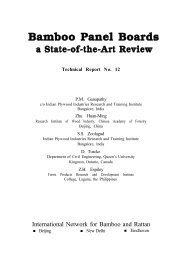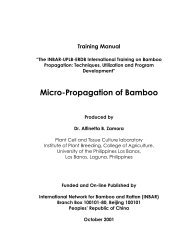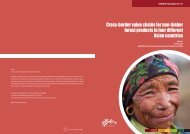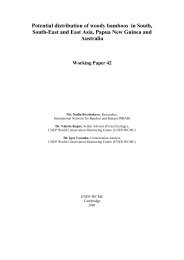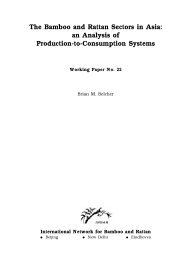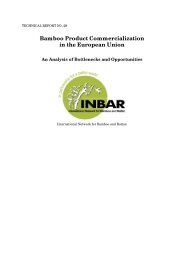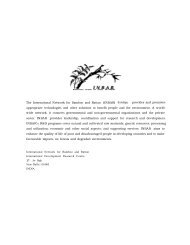ISSN ………… - International Network for Bamboo and Rattan
ISSN ………… - International Network for Bamboo and Rattan
ISSN ………… - International Network for Bamboo and Rattan
You also want an ePaper? Increase the reach of your titles
YUMPU automatically turns print PDFs into web optimized ePapers that Google loves.
cent arabinose <strong>and</strong> 12.8 per cent uronic acid; the acetyl <strong>and</strong> methoxyl value being nil (Negi 1969 309 ;<br />
1970) 310 . The hemicellulose of Bambusa bambos contains 78.8 per cent xylose, 11.6 per cent<br />
arabinose <strong>and</strong> 1.8 per cent galactose (Guha <strong>and</strong> Pant 1967) 394 . Xylose (82-92% yield) was the main<br />
constituent of the hemicelluloses isolated from Dendrocalamus strictus, D. hamiltonii <strong>and</strong> Melocanna<br />
baccifera (Dhawan <strong>and</strong> Singh 1982) 278 . Glucose, arabinose, rhamnose <strong>and</strong> glucuronic acid were also<br />
found to be present in small amounts in all the hemicellulose isolates. The yield of sugars was highest<br />
in the case of D. strictus whereas pentosans <strong>and</strong> methoxyl content were the highest in the case of D.<br />
hamiltoni, Melocanna baccifera had the lowest yield of sugars, pentosans <strong>and</strong> methoxyl content.<br />
As pentosans constitute more than 85 per cent of the hemicelluloses, their effect on pulping<br />
characteristics is important. The pentosans are reported to be retained in the cellulose pulps even after<br />
a final stage of cold-alkali purification with 17.5per cent NaOH. This suggests that there are ‘alkali<br />
resistant’ pentosans in close association with the cellulose proper (Negi 1970) 310 . A probable inter-<br />
relation between cellulose, lignin <strong>and</strong> hemicellulose in Dendrocalamus strictus is described by<br />
Mukherjea <strong>and</strong> Guha (1971) 307 in their studies on the methods <strong>for</strong> isolating cellulose from lignin <strong>and</strong><br />
pentosan components. Once the pentosans are rendered non-resistant, treatment with alkali be<strong>for</strong>e<br />
chlorite treatment produces pulps with a high content of resistant pentosans whereas chlorite treatment<br />
alone makes the pentosans non-resistant to alkali extraction (Guha <strong>and</strong> Negi 1972) 394 . Maximum<br />
amount of alkali resistant pentosans are retained in chlorite pulp <strong>and</strong> minimum in the sulphate pulp of<br />
Dendrocalamus strictus (Singh et al. 1974) 317 . Biyani et al. (1967) 378 obtained a pulp with low<br />
pentosan content from Bambusa bambos by nitric acid pulping. Prehydrolysis /sulphate process may<br />
be the only effective means of removing the pentosans from bamboo chips (at a cost of considerable<br />
loss of alpha-cellulose) <strong>and</strong> thus enabling a dissolving-grade pulp to be obtained (Bawagan 1968) 268 .<br />
The pentosans present <strong>and</strong> ash content of the various bamboos used in India <strong>for</strong> making rayon pulp<br />
were reported by Saboo (1992) 482 .<br />
<strong>Bamboo</strong> lignin is a typical grass lignin composed of mixed dehydrogenation polymers of coniferyl,<br />
sinapyl <strong>and</strong> p-coumaryl alcohols. The unique feature of bamboo lignin is that it contains 5-10 per cent<br />
ester of p-coumaric acid (Higuchi 1958 288 , Higuchi <strong>and</strong> Kaivamura 1966) 289 . Lignin of D. strictus is<br />
found to be composed of two fractions, one carrying high methoxyl value (19%) <strong>and</strong> the other having<br />
low value (2%) (Pant et al. 1975) 311 . The <strong>for</strong>mer is easily extractable under mild conditions whereas<br />
the latter requires drastic conditions. Aldol type side chain (R-CH-(OH)-CH2-CHO) <strong>and</strong> presence of<br />
bivanillyl structure with alpha-alpha linkage <strong>and</strong> 1-(4-hydroxy-3-methoxy)-3 hydroxy propane-1-one<br />
have been suggested <strong>for</strong> the bamboo lignin. Vanillic acid, vanillin <strong>and</strong> syringaldehyde are present as<br />
terminal moieties <strong>and</strong> are linked through beta-position of side chain of the main precursors via<br />
carboxylic acid group (Bist et al. 1974 275 ; 1975 276 ; Sabharwal et al. 1962) 313 .<br />
41



